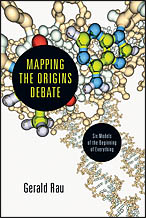
Perhaps I’m stating the obvious but most discussions of origins seem to generate far more heat than light. They preach to the choir of those who agree, fail to engage those with whom they disagree on their own terms and perpetuate the unfortunate notion that Christianity and science are at war with each other. Gerald Rau’s Mapping the Origins Debate: Six Models of the Beginning of Everything (InterVarsity Press, 2012) is a notable exception to that trend in that it is intended to promote understanding and conversation rather than more controversy.
Gerald Rau takes a novel approach in this book. Rather than taking a side, he lays out six different models that may be found in the current discussions. This itself is important because most of the coverage of this issue assumes two very diametrically opposed options: naturalistic evolution, that there is no god and the universe and all life arose simply through physical causation, and young earth creationism, which treats Genesis 1 as a literal account of how God created the world in six literal days, a world that is approximately 10,000 years old.
Rau identifies four other models and their proponents:
Non-Teleological Evolution: There is a deity but once the universe was created, it developed and evolved apart from any intention of God. This would be Ian Barbour’s position.
Planned Evolution: This assumes a deity who created the universe so perfectly that it evolved according to God’s plan without further intervention. Francis Collins and the Biologos folk would hold this.
Directed Evolution: This assumes a deity who creates the universe and intervenes to direct natural processes. Michael Behe and Loren Haarsma would hold to this model.
Old Earth Creationism: This would take a day-age approach to reading Genesis that assumes God’s creative work in each of these “long days” in which at least the major body plans of living creatures were created separately and did not evolve. Hugh Ross would be a representative of this group.
What Rau then does is shows how each of these models treats four major aspects of origins. His observation is that throughout, all six models are dealing with the same evidence but their interpretation of this evidence is shaped by differing fundamental presuppositions that account for the differences in the models. The four major areas Rau surveys are the origin of the universe, the origin of life, the origin of species, and the origins of humans.
Rau observes that there are difficulties every model has with the evidence as well as varying explanations of both the evidence and the difficulties. For example, the anthropic principle, that observes the existence of 26 constants that allow for the existence of organic life, including human beings poses difficulties for the idea of a randomly arising universe of naturalistic evolution, although proponents would argue that in a multiverse with infinite universes, at least one would satisfy these requirements. Similarly, the commonalities of genetic material across species and the relatively small genetic difference between humans and apes pose questions for those who would argue against some form of evolution, explained by the use of “common design”.
Rau contends that rather than the currently polarized camps around these models, what might be more helpful is recognizing that it might be possible for each to learn from the others, that each has insights that may be useful in explaining some evidence and that this could be more fruitful than our present debates.
His conclusion however goes to the heart of the differences that exist, which are differing definitions of science, and fundamental disagreements about the existence of a God and whether such a God is involved with the physical world and how. My question as I consider this is whether these deepest differences can either be over come or held in abeyance to realize the kind of interchange between proponents of the different models that Rau hopes for.
If that kind of engagement is ever to occur, the work Gerald Rau has done lays excellent groundwork for such interchange. And for those trying to understand the different positions in the origins debate, Rau gives us an excellent “map” of the landscape.
Note: Also posted as Review: Mapping the Origins Debate: Six Models of the Beginning of Everything on Bob on Books (Bob Trube. 4/25/2014).
Footnote added by the editor:
- Gerald A. Rau (Ph.D., Cornell) is founder and chief editor at Professional English International, Inc., a team providing high quality editing services in English academic writing, based at National Chung Cheng University in Chiayi, Taiwan. He was previously an adjunct professor teaching biology courses at Wheaton College in Wheaton, IL and at Trinity Christian College in Palos Heights, IL. Rau has an impressive history of education with degrees in Biology, Science Education, Horticulture, Plant Breeding, Vegetable crops and International Agriculture, which are all subjects he continues to include in his writings as an independent scholar. — From the Author page for Mapping the Origins Debate. Accessed 3/4/2014. For a related piece by Tom Ingebritsen, in his Christianity and science series, which draws from Rau’s work visit Christian Views of Creation. ↩
Bob Trube is Associate Director of Faculty Ministry and Director of the Emerging Scholars Network. He blogs on books regularly at bobonbooks.com. He resides in Columbus, Ohio, with Marilyn and enjoys reading, gardening, choral singing, and plein air painting.

Leave a Reply